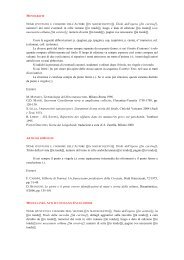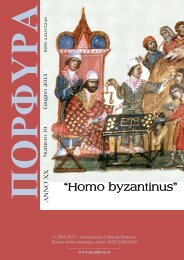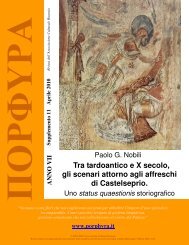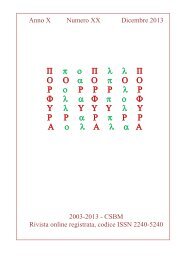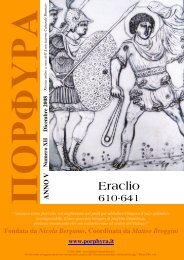ΠΟΡΦΥΡΑ - Porphyra
ΠΟΡΦΥΡΑ - Porphyra
ΠΟΡΦΥΡΑ - Porphyra
Create successful ePaper yourself
Turn your PDF publications into a flip-book with our unique Google optimized e-Paper software.
A Prôtospatharios, Magistros, and Strategos Autokrator of 11 th cent.<br />
the equipment of Georgios Maniakes and his army according to the Skylitzes Matritensis miniatures<br />
and other artistic sources of the middle Byzantine period.<br />
laces, crossed on breast. It is the so-called Varangian Bra. 239<br />
This chest harness is represented in a very large number of<br />
artistic sources of the middle period, as fitting of κλιβανια as<br />
well of other kinds of armour 240 . It was already used in Late<br />
Roman Times, and closed by small buckles joint with small<br />
rings on the frontal breast 241 . A major problem is the<br />
interpretation of the way of fastening in the middle Byzantine<br />
age, because the East-Roman sources do not mention such<br />
arrangements. My own personal opinion is that there were<br />
various methods in use. The system I reconstructed derives from<br />
the system suggest to me by Gamber, in his reconstruction of the<br />
Roman leather muscled armour of the Sutton Hoo burial ship 242 .<br />
A buckle strap end (fig. 11 n. 30), 243 found in Garvan, in<br />
Romania, really belonged to a Varangian Warrior, and could<br />
have been fastened and buckled at the centre of the bra back by<br />
a piece of strap. I would prefer such a position for the bra<br />
fastening buckle because less exposed at the danger of a enemy<br />
blow frontally directed which could loose the harness. A<br />
reference to the shoulder reinforcements is may in the passage<br />
described by Leo Taktika, V, 4, where, beside the mention of the<br />
κρινκελλοι or rings for the mail λωρικιον, he provides that<br />
armours should be held also by λωρια, i.e. straps. The<br />
transversal strap, stretched at front and back by two rings on<br />
both sides, or by a back horizontally fastened buckle, or sides<br />
laced under the armpits 244 , holds tightly the κλιβανιον or other<br />
armours preventing it from moving during the battle.<br />
The reconstructed sword (spathion, fig. 12) is East-<br />
Roman, about 86 cm. long, and has been copied from the<br />
239 See Wyley S., The Chest Harness known as the Varangian Bra, in Varangian Voice n. 28 pp. 29-30.<br />
240 See Heath, Byzantine Armies, pp. 31, 34, 35,36.<br />
241 See the 4 th century Roman warrior shown in a mosaic of Amazonomachia from Antiochia, now in Louvre; I have the<br />
photo in my photographic archive. It was may be a armour harness derived from Sassanian Persians. See Nicolle,<br />
Sassanian Armies, pp. 18 fig. 11, 22 fig. 14, and pls. D1-F3; Wyley, The Chest, p. 29 ; Hoffmeyer, Military Equipment,<br />
fig. 17.<br />
242 Gamber O., The Sutton Hoo military Equipment, an attempted reconstruction, in The Journal of The Arms and<br />
armours society, Vol. V, n. 6 june 1966, pp. 265-289 and pl. LVII.; Idem, Kataphrakten, Klibanarier,<br />
Normannenreiter, in “Jahrbuch der Kunsthistorischer Sammlungen”, Wien, 1968, p. 35 fig. 53.<br />
243 See Diaconu, Dinogetia, p. 299-300, fig. 173 n. 26 ; it is of gilded bronze, discovered in 1950 in the sector A of the<br />
city, and dated to 11 th century ; its dimension are 0,046 x 0,016 m. ; a extremity is cut while the other is round shaped,<br />
may be to imitate an animal head. Over the convex face is executed, by pressing, a ornament tuft shaped, interlaced<br />
with another one arched, with symmetrical branches disposed longitudinally on a surface, with a internal decoration<br />
partially of animal, partially of vegetal aspect, typical of the Germanic Nord Europe and classified as of the II Germanic<br />
style. On the back two rivets were used to fixed an ornamental plaque to the strap.<br />
This ornament, with Norman decoration, together with a sabre cross guard discovered in Gravan (s. p. 337), are<br />
classified by archaeologists as trade objects of Russo-Scandinavian origin passing through the so called “road of the<br />
Varangians to the land of Greeks”, from the Baltic Sea to Constantinople. Garvan and Dinogetia were part of the<br />
Thèma Paristion and were land of passage and recruitment for the Varangians enroled as mercenaries in the East-<br />
Roman army. S. also Barnea N., Preliminary reports of memorial stones of Besarabia, in Dacia, VI, 1962, pp. 293-316,<br />
in russian, especially pp. 311-316.<br />
244 Cfr..alternative or cumulative hypothesis in Byzantine Lamellar armour, Much Ado about bondage, of Nicholson-<br />
Alaric of Lothian 1989-1990, on Internet, A/Byzantine Lamellar armour.htm.<br />
40



